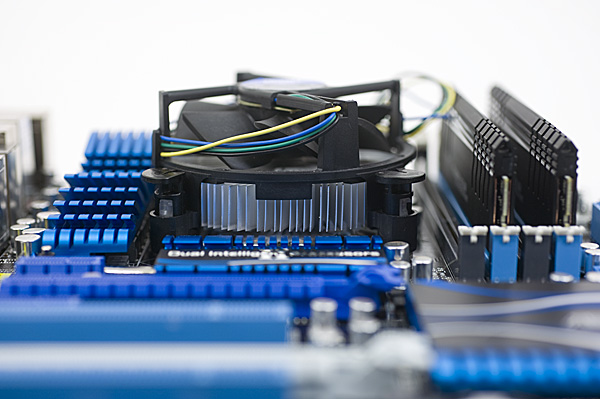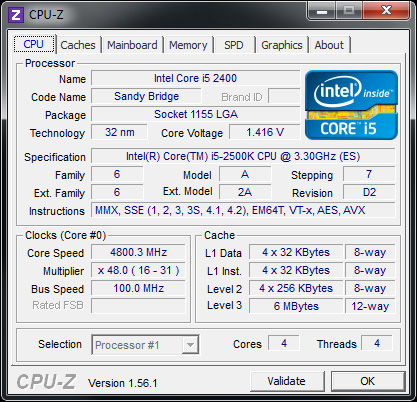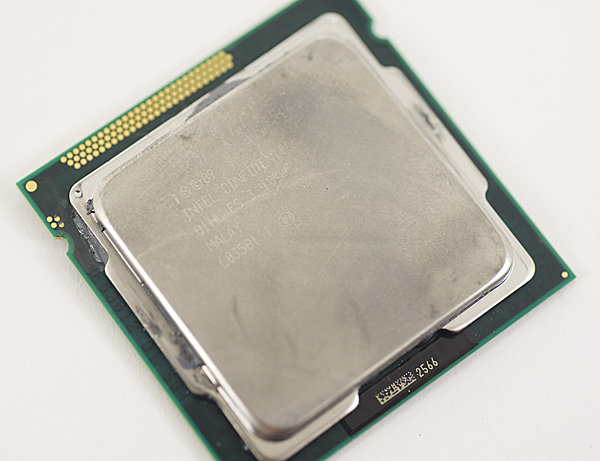The Sandy Bridge Review: Intel Core i7-2600K, i5-2500K and Core i3-2100 Tested
by Anand Lal Shimpi on January 3, 2011 12:01 AM ESTOverclocking, the K-Series and What You’ll Want to Buy
If you haven’t noticed, the computing world is becoming more integrated. We review highly integrated SoCs in our smartphone coverage, and even on the desktop we’re seeing movement towards beefy SoCs. AMD pioneered the integrated memory controller on desktop PCs, Intel followed suit and with Lynnfield brought a PCIe controller on-die as well. Sandy Bridge takes the next logical step and brings a GPU on-die, a move matched by AMD with Brazos and Llano this year.
In the spirit of integration, Intel made one more change this round: the 6-series chipsets integrate the clock generator. What once was a component on the motherboard, the PLL is now on the 6-series chipset die. The integrated PLL feeds a source clock to everything from the SATA and PCIe controllers to the SNB CPU itself. With many components driven off of this one clock, Intel has locked it down pretty tight.
With Nehalem and Westmere, to overclock you simply adjusted the BCLK from 133MHz to whatever speed you wanted and sometimes toyed with multipliers to arrive at a happy end result. With Sandy Bridge, the BCLK generated on the 6-series PCH is at 100MHz by default and honestly won’t go much higher than that.
While I’ve heard reports of getting as high as 115MHz, I’d view 103—105MHz as the upper limit for what you’re going to get out of BCLK overclocking. In other words: next to nothing. A 105MHz BCLK overclock on a Core i7-2600 will take you from a stock speed of 3.4GHz to a whopping 3.57GHz. The form of overclocking we’ve been using for the past decade is effectively dead on Sandy Bridge.
Years ago, before the Pentium II, we didn’t rely on BCLK (or back then it was just FSB or bus overclocking) to overclock. Back then, if we wanted a faster CPU we’d just increase the clock multiplier. Intel has dabbled in offering multiplier unlocked parts for overclockers, we saw this last year with the Core i7 875K for example. With Sandy Bridge, those unlocked parts are going to be a lot more important to overclockers.
It works like this. If you have a part that does not support Turbo (e.g. Core i3-2100 series), then your CPU is completely clock locked. You can’t overclock it at all, have fun at your stock frequency. This is good news for AMD as it makes AMD even more attractive at those price points.
If you have a part that does support turbo (e.g. Core i5-2400), then you have what’s called a “limited unlocked” core—in other words you can overclock a little bit. These parts are limited to an overclock of 4 processor bins above and beyond the highest turbo frequency. Confused yet? This chart may help:
In this case we’re looking at a Core i5-2500, which runs at 3.3GHz by default. When a single core is active, the chip can turbo up to 3.7GHz. If you want, you can change that turbo state to go as high as 4.1GHz (if your CPU and cooling can keep up).
Overclocking these limited unlocked chips relies entirely on turbo however. In the case above, the fastest your chip will run is 4.1GHz but with only one core active. If you have four cores active the fastest your chip can run is 3.8GHz. While Intel didn’t sample any limited unlocked parts, from what I’ve heard you shouldn’t have any problems hitting these multiplier limits.
There’s a third class of part: a fully unlocked K-series chip. At launch there are only two of these processors: the Core i5-2500K and the Core i7-2600K. Anything with a K at the end of it means you get all multipliers from 16x all the way up to 57x at your disposal. It’s effectively fully unlocked.

These chips overclock very well. Both my Core i5-2500K and Core i7-2600K hit ~4.4GHz, fully stable, using the stock low-profile cooler.

This is all you need for 4.4GHz
With a bit more effort and a better cooler, you can get anywhere in the 4.6-5.0GHz range:

It's a bit too early to tell how solid these near-5GHz overclocks will be, but I'm confident in the sub-4.5GHz overclocks we were able to sustain.
You do pay a price premium for these K-series SKUs. The 2500K will cost you another $11 over a stock 2500 and the 2600K costs an extra $23. In the case of the 2500K, that’s a small enough premium that it’s honestly worth it. You pay $11 extra for a chip that is very conservatively clocked and just begging for you to overclock it. Even the 2600K’s premium isn’t bad at all.
| Model Number | Standard SKU | K-Series SKU | Price Premium |
| Intel Core i7-2600 | $294 | $317 | +$23 |
| Intel Core i5-2500 | $205 | $216 | +$11 |
As an added bonus, both K-series SKUs get Intel’s HD Graphics 3000, while the non-K series SKUs are left with the lower HD Graphics 2000 GPU.
Compared to Lynnfield, you’re paying $11 more than a Core i5-760 and you’re getting around 10-45% more performance, even before you overclock. In a perfect world I’d want all chips to ship unlocked; in a less perfect world I’d want there to be no price premium for the K-series SKUs, but at the end of the day what Intel is asking for here isn’t absurd. On the bright side, it does vastly simplify Intel’s product stack when recommending to enthusiasts: just buy anything with a K at the end of it.
Since we’re relying on multiplier adjustment alone for overclocking, your motherboard and memory actually matter less for overclocking with Sandy Bridge than they did with P55. On both P67 and H67, memory ratios are fully unlocked so you can independently set memory speed and CPU speed. Even the GPU ratios are fully unlocked on all platforms and fully independent from everything else.












283 Comments
View All Comments
hmcindie - Monday, January 3, 2011 - link
Why is that Quick Sync has better scaling? Very evident in the Dark Knight police car image as all the other versions have definite scaling artifacts on the car.Scaling is something that should be very easy. Why is there so big a difference? Are these programs just made to market new stuff and no-one really uses them because they suck? So big scaling differences between codepaths make no sense.
JarredWalton - Monday, January 3, 2011 - link
It looks to me like some of the encodes have a sharpening effect applied, which is either good (makes text legible) or bad (aliasing effects) depending on your perspective. I'm quite happy overall with the slightly blurrier QS encodes, especially considering the speed.xxxxxl - Monday, January 3, 2011 - link
I've been so looking forward to SB...only to hear that H67 cant overclock CPU?!?!?!?!Disappointed.
digarda - Monday, January 3, 2011 - link
Who needs the IGP for a tuned-up desktop PC anyway? Some for sure, but I see the main advantages of the SB GPU for business laptop users. As the charts show, for desktop PC enthusiasts, the GPU is still woefully slow, being blown away even by the (low-end) Radeon 5570. For this reason, I can't help feeling that the vast majority of overclockers will still want to have discrete graphics.I would have preferred to dual core (4-thread) models to have (say) 32 shaders, instead of the 6 or 12 being currently offered. At 32nm, there's probably enough silicon real estate to do it. I guess Intel simply didn't want the quad core processors to have a lower graphics performance than the dual core ones (sigh).
Pity that the socket 2011 processors (without a GPU) are apparently not going to arrive for nearly a year (Q4 2011). I had previously thought the schedule was Q3 2011. Hopefully, AMD's Bulldozer-based CPUs will be around (or at least imminent) by then, forcing intel to lower the prices for its high-end parts. On the other hand, time to go - looks like I'm starting to dream again...
Exodite - Monday, January 3, 2011 - link
Using myself as an example showing the drawback of limiting overclocking on H67 would be the lack of a good selection of overclocking-friendly micro-ATX boards due to most, if not all, of those being H67.Granted, that's not Intel's fault.
It's just that I have no need for more than one PCIe x16 slot and 3 SATA (DVD, HDD, SSD). I don't need PCI, FDD, PS2, SER, PAR or floppy connectors at all.
Which ideally means I'd prefer a rather basic P67 design in micro-ATX format but those are, currently, in short supply.
The perfect motherboard, for me, would probably be a P67 micro-ATX design with the mandatory x8/x8 Crossfire support, one x1 and one x4 slot, front panel connector for USB 3, dual gigabit LAN and the base audio and SATA port options.
Gigabyte?
Anyone? :)
geofelt - Monday, January 3, 2011 - link
The only P67 based micro-ATX motherboard I have found to date is theAsus P8P67-M pro. (or evo?)
Any others?
Rick83 - Monday, January 3, 2011 - link
There's also a non-pro P8P67-M.Keep in mind though, that the over-clocking issue may not be as bad as pointed out. There are H67 boards being marketed for over-clocking ability and manuals showing how to adjust the multiplier for CPUs... I'm not yet convinced over-clocking will be disabled on H67.
smilingcrow - Monday, January 3, 2011 - link
Major bummer as I was going to order a Gigabyte H67 board and an i5-2500K but am put off now. They seem to over-clock so well and with low power consumption that it seemed the perfect platform for me…I don’t mind paying the small premium for the K editions but being forced to use a P67 and lose the graphics and have difficulty finding a mATX P67 board seems crazy!
I wonder if this limit is set in the chipset or it can be changed with a BIOS update?
DanNeely - Monday, January 3, 2011 - link
Quick Sync only works if the IGP is in use (may be fixable via drivers later); for anyone who cares about video encoding performance that makes the IGP a major feature.mariush - Monday, January 3, 2011 - link
On the Dark Knight test...Looking at the Intel software encoding and the AMD encoding, it looks like the AMD is more washed out overall, which makes me think there's actually something related to colorspaces or color space conversion involved....
Are you guys sure there's no PC/TV mixup there with the luminance or ATI using the color matrix for SD content on HD content or something like that?